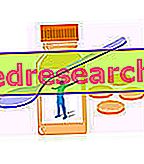Generality
Androstenedione is a hormone secreted in the plasma by the adrenal glands, by the testicle in humans and by the ovary in women. This hormone is produced as an intermediate of the biochemical pathway leading to the synthesis of testosterone, estrone and estradiol.

Androstenedione can be used as a marker of adrenal, testicular and ovarian function, and allows the evaluation of androgen production .
High blood levels can be found in the presence of adrenal hyperplasia, polycystic ovary and various neoplastic processes.
In adult humans, an excess of androstenedione does not cause macroscopic signs, but in women it can cause virilization (appearance of male secondary characters) and amenorrhea.
Androstenedione is one of the sex hormones responsible for the differentiation of male and female characteristics (such as beard and deep voice in humans).
An excess of this hormone or other androgens can cause abnormalities in children's genital organs, hirsutism (excess body hair), changes in the menstrual cycle in girls and precocious puberty in males.
What's this
Androstenedione, or 4-androstenedione, is a steroid hormone with 19 carbon atoms, produced by the adrenal gonads. A small amount is also synthesized at peripheral level, starting from specific precursors (dehydroepiandrosterone and 17-hydroxyprogesterone).
In turn, andostrenedione is the precursor of estrogen estradiol and estrone (female sex hormones), and androgen testosterone (the male sex hormone par excellence). This characteristic limits the possibilities of use of androstenedione as a pro-hormone able to increase serum testosterone levels; the simultaneous increase in the conversion to estrogen tends to cancel the presumed anabolic effects (increase in muscle mass) and ergogenic effects (increase in strength).
In the female, androstenedione is produced, under the stimulus of pituitary gonadotropins, from theca cells, and readily converted to estrone by granulosa cells. Both of these cells are part of the ovarian follicle, that is, of the structure containing the egg cell and its coating. The outer layer of the follicle consists of cells of the theca, the innermost one from granulosa cells.
Adrenal synthesis of androstenedione - a higher percentage after menopause - occurs under stimulation of pituitary ACTH.

Why do you measure
The examination of androstenedione is useful when it is necessary:
- Evaluate the functionality of the adrenal glands;
- Establish the cause of virilization (appearance of male secondary characters) in females and signs of precocious puberty in male children (hirsutism, lowering of the voice, increased musculature and increase in the size of the genitals);
- Test the production of androgens and gonadal functions (ie ovaries and testicles).
The determination of androstenedione can be indicated by the doctor contextually or after other tests - such as the testosterone test and 17-OH progesterone - when an androgen is overproduced (or, more rarely, a deficiency).
Androstenedione can also be measured if puberty is late or when the woman has infertility, in the presence of signs such as hirsutism (abundant hair on the face and body), acne, absence of menstrual cycle (amenorrhea) or irregular menstruation and baldness typically male alopecic site.

The androstenedione dosage can also be used to periodically monitor glucocorticoid treatment for congenital adrenal hyperplasia.
Normal values
Physiological plasma levels of Androstenedione | |
Babies | 20-290 ng / dL or 0.7-10.1 mmol / L |
Pre puberty | 8-50 ng / dL or 0.3-1.7 mmol / L |
Adult women | 75-205 ng / dL or 2.6-7.2 mmol / L |
Adult men | 85-275 ng / dL or 0.3-9.6 mmol / L |
Postmenopausal women | <10 ng / dL or 0.35 mmol / L |
Reference values may vary from laboratory to laboratory
Androstenedione High - Causes
Although the androgenic activity of the hormone is only 1/5 of that of testosterone, in women the high serum levels of androstenedione are often associated with acne, hirsutism, virilization and androgenetic baldness.
Values higher than those of reference, especially if associated with elevated luteinizing gonadotropin (LH), point towards a possible diagnosis of polycystic ovary syndrome (Stein-Leventhal syndrome), while in Cushing's syndrome they are accompanied by hypercortisolism.
Definitely high values (> 30 nmol / L) may suggest a hormone-secreting adrenal or ovarian tumor.
Androstenedione Low - Causes
Lower than normal androstenedione values are typical of adrenal insufficiency.
How to measure it
To measure androstenedione levels, the patient must have blood drawn from a vein in his arm.
Preparation
Before undergoing the sample for the determination of androstenedione, it is necessary to observe a fast of at least 8 hours. During this period, a small amount of water can be taken.
Blood androstenedione levels vary throughout the day and during the ovarian cycle in women. Therefore, in fertile women, it is recommended to undergo the examination a week before or one after the onset of menstruation.
Interpretation of Results
- A normal concentration of androstenedione in the blood, associated with an adequate result of other adrenal activity assessment tests, should indicate that the glands are functioning properly.
- An increased concentration of androstenedione in the blood indicates an increase in production by the adrenal glands, ovaries or testicles. A high level of this hormone is not in itself diagnostic, but indicates the need to deepen the clinical picture with further investigations. An increase in androstenedione may depend, in fact, on various conditions, including adrenal tumors and polycystic ovary syndrome (PCOS).
- Low concentration could indicate adrenal, ovarian or testicular dysfunction.
The androstendione can be inserted in the panel of anti-doping tests. Sometimes, in fact, this hormone can be taken illegally as a drug by athletes to improve their performance. As with other anabolic steroids (synthetic testosterone analogues), this practice is not without its negative consequences, including cardiovascular diseases and liver damage.



